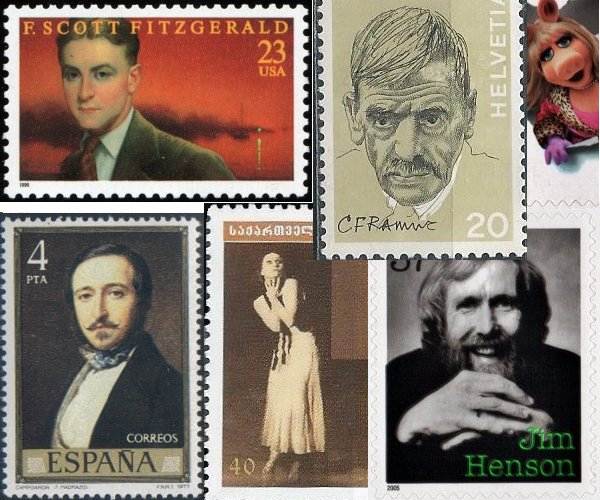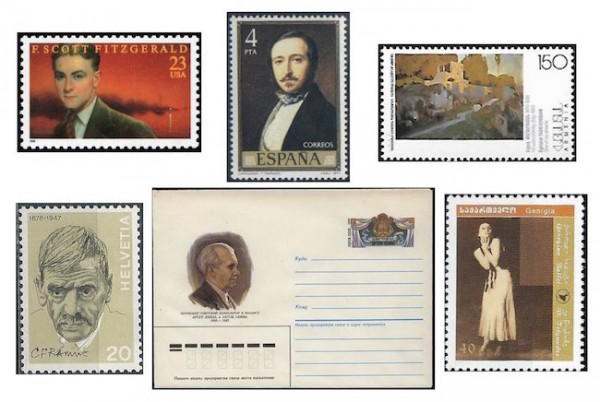The Arts on Stamps of the World — September 24
An Arts Fuse regular feature: the arts on stamps of the world.

By Doug Briscoe
After yesterday’s torrent of talent, we have for today just half a dozen artists, chief among them F. Scott Fitzgerald (September 24, 1896 – December 21, 1940).
Francis Scott Key was a distant cousin. A closer cousin was Mary Surratt, convicted of conspiracy in the assassination of Abraham Lincoln (and hanged). Fitzgerald was born in Saint Paul and grew up all over: Buffalo, West Virginia, Syracuse, back to Saint Paul, and New Jersey, where he stayed on to attend Princeton. One of his friends there was Edmund Wilson. He dropped out to join the army in 1917 and had Dwight Eisenhower as one of his instructors. He met Zelda Sayre while stationed in Alabama and married her after the success of his first published novel This Side of Paradise (1920). His later works, including The Great Gatsby, did not do so well. Fitzgerald suffered from alcoholism and Zelda from schizophrenia. He had two heart attacks before the third one claimed him.
Today marks the bicentenary of the birth of Ramón de Campoamor y Campoosorio (September 24, 1817 – February 11, 1901), a Spanish realist poet and philosopher. He was born in Asturias, studied medicine, went into politics, and became governor of three Mediterranean provinces. His first publication as a poet was the Ternezas y flores (1840), a fine debut volume that apparently he never bettered. (The Wikipedia article in general tends to be rather dismissive of his efforts, describing his plays as “interesting experiments; but they are totally lacking in dramatic spirit.”) He wrote in (created?) an ill-defined poetic form called doloras, the first set appearing in 1846, and the article grudgingly admits, “It cannot be denied that in the Doloras Campoamor’s special gifts of irony, grace, and pathos find their best expression.” Campoamor has no stamp dedicated to him, but a portrait of the poet appears as one of a set of stamps remembering the painter Federico de Madrazo, and that will have to do.
Speaking of painters, we turn to the Armenian Yeghishe Tadevosyan (24 September 1870 – 22 January 1936), born in Etchmiadzin. He studied and lived in Moscow, traveled to several times to the Middle East, and settled in Tbilisi in 1901. In 1916 he founded and directed the Union of Armenian Artists and in 1935 was named an “Honored Artist” by the Armenian SSR. The 1997 stamp presents his work One of My Dreams.
Swiss writer Charles-Ferdinand Ramuz (September 24, 1878 – May 23, 1947) was born and educated in Lausanne. He lived in Paris from 1903, when he published his first poetry collection, Le petit village, to the outbreak of World War I. His most celebrated work is probably the libretto he wrote for Igor Stravinsky’s chamber stage work L’Histoire du soldat, which was premièred in 1918 in Ramuz’s home town of Lausanne under the direction of Ernest Ansermet. The story was based on a folk tale derived from Alexander Afanasyev’s collection. Ramuz is honored not only on the Swiss stamp of 1972 but also on the current Swiss 200 franc note.

Estonian composer Artur Lemba, born in Tallinn on September 24, 1885, can claim a number of firsts, including credit for the first Estonian opera (Sabina, 1905) and the first Estonian symphony (1908), which can be heard on one of two Chandos albums issued years ago under the rubric “Music from Estonia”, with Neeme Järvi conducting. Lemba studied at the St. Petersburg Conservatory under Glazunov and Rimsky-Korsakov and, upon graduation, received the Anton Rubinstein prize, a Schröder piano! He died on November 21, 1963, in his native Tallinn. The envelope seen here was issued on the occasion of his centennial in 1985.
Georgian ballerina Vera Tsignadze (born 1924 in Baku) is a ballet teacher who danced in the Soviet era. She was winner of the Stalin Prize in 1948 and 1951 and People’s Artist of the Georgian SSR in 1955. She toured in the US, Western Europe, and South America and often danced with Vakhtang Chabukiani, who was honored with her in a pair of stamps issued by the independent nation of Georgia in 2005. Since 1969 she has taught classical dance in the Tbilisi Choreographic School. She has a page on Facebook!
The grandest philatelic display we have today is for American puppeteer Jim Henson (September 24, 1936 – May 16, 1990). In 2005 the USPS issued a sheet of eleven stamps showing Henson himself along with ten of his Muppet creations, Kermit the Frog and Miss Piggy among them. For some reason Bert and Ernie were omitted, but they got their stamps in an issue from the Netherlands, and Cookie Monster shows up on one from Samoa. You’re probably familiar with Henson’s contributions to the Star Wars franchise, but if you don’t know it—and if you like that sort of thing—do watch the engaging fantasy The Dark Crystal (1982), a very well made film co-written and co-directed by Henson, who also supplied some of the character voices.
Today is also the anniversary of the death of Duarte Lobo (or Eduardus Lupus; c1565–1646), a composer of the golden age of Portuguese polyphony. Although he lived well into the Baroque era, he mostly remained faithful to the Renaissance style embodied by Palestrina.

For the heck of it I throw in a 1956 US stamp showing Devil’s Tower, which fifty years earlier (September 24, 1906) had been set aside by President Theodore Roosevelt as the nation’s first National Monument.
Although today is the 300th anniversary of his birth, there’s no stamp for the author of The Castle of Otranto (1764), Horace Walpole, 4th Earl of Orford (24 September 1717 – 2 March 1797). If you want pictures, there’s a portrait of him by Joshua Reynolds and a drawing by Thomas Lawrence.
A graduate of the University of Massachusetts with a B.A. in English, Doug Briscoe worked in Boston classical music radio, at WCRB, WGBH, and WBUR, for about 25 years, beginning in 1977. He has the curious distinction of having succeeded Robert J. Lurtsema twice, first as host of WGBH’s weekday morning classical music program in 1993, then as host of the weekend program when Robert J.’s health failed in 2000. Doug also wrote liner notes for several of the late Gunther Schuller’s GM Recordings releases as well as program notes for the Boston Classical Orchestra. For the past few years he’s been posting a Facebook “blog” of classical music on stamps of the world, which has now been expanded to encompass all the arts for The Arts Fuse.
